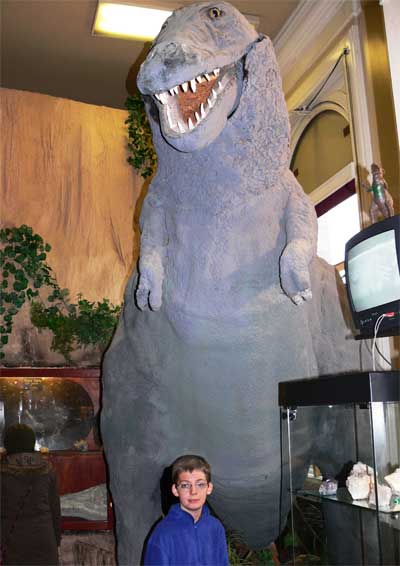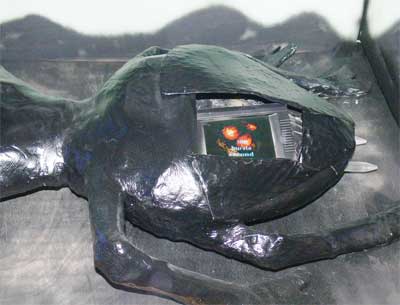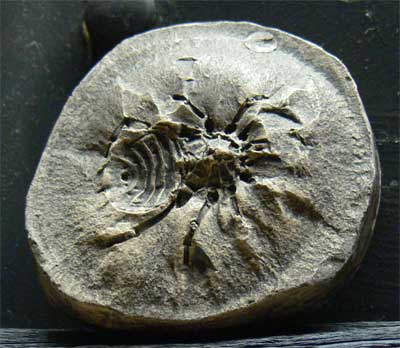Inside the UK’s Creationist museum (Part 2)
- Complaining about the Mainland - 17th August, 2024
- New island designation – is it just greenwash? - 26th April, 2024
- Police and Crime Commissioners – a solution or a problem? - 21st April, 2024
Genesis Expo is the UK’s largest and most popular Creationist museum.

In a series of three articles on The Ranger’s Blog you will find out what happened when The Ranger and the Wildlife Gardener – both unapologetic Darwinists – took a day off and visited Genesis Expo. Part one is already published; part two is below. The museum is inside an old bank building, so is not particularly large. However the space is well-used, with a front display area and shop, a small lecture room at the back, and to the side, a dark corridor lined with what are rather optimistically described as “12 dioramas on creation themes using use computer-run lighting sequences”. Now, I don’t intend to go through all of these dioramas and assess them in any systematic manner – much as I’d enjoy doing so. I’ll pick out a few gems, of course, but as it is, fellow blogger Paul S. Jenkins has already gone into this in remarkable detail. I’d recommend a visit to his entertainingly-named blog, ‘Notes from an evil burnee‘, if you want to read that sort of thing. What our expedition set out to do was see how the museum fared with a sample audience of rather sceptical grown-ups and a range of children of an enquiring disposition. In part one we looked at our expectations. One of these at least was refuted as soon as we walked in. Instead of what Jack had predicted: “people with suits on screaming about God“, there was no sign of any evangelism. One friendly but quiet chap sat behind the counter and nodded us in with a polite greeting. In fact, there was nothing particularly religious to be seen at all. This, it turns out, is no accident. A Creation Science Movement leaflet offers an insight to the purpose of the museum:
An overt gospel challenge would cause the man-in-the-street to turn and run. Hence CSM’s Genesis Expo offers scientific reasons why Creation rather than evolution theory is credible.
In fact the only hint of anything directly proselytising was a bizarre mural which was high up in the display and, whilst very large, was hardly dominant. It showed heavenly hands reaching down to some rather curious creatures – possibly those unlucky creations which perished in the flood, becoming fossils.

The exhibition itself was pitiful stuff on more-or-less every level, as you can see from Paul S. Jenkins’ pictures and description. Genesis Expo failed to achieve the most basic thing which any museum should do: capture interest. It was a dull display, poorly presented. Any message, however worthy, would have been poorly served by the ancient-looking audio tech, the laughable models and the large blocks of densely-written text to read.

This model of a bombardier beetle appears to be made of papier mache with a Gameboy inside it.
Secondly, the arguments as presented were weak enough that even our twelve-year old subject, Bill, was able to pick some holes in them, for example pointing out to me that the assertion that ‘there are no transitional fossils’ seemed to ignore the evidence of archaeopteryx. Certainly much of what was shown seemed to have the ‘feel’ of a scientific argument, but even then in parts it was not consistent even with itself. To give an example that I couldn’t really be expected to pass over, one display features what is labelled as a ‘fossil spider’ (It quite obviously is actually not a genuine fossil but a cast, but that’s beside the point).

The text beneath it says:
This display shows you something fossilised, and alongside it a present day example which is just the same as the fossil. The fossil evidence shows that creatures remain unchanged with time and do not evolve into something different.
Now don’t get me started, but if you look carefully at the ‘fossil’, can you see the problem here? This spider has a fully segmented abdomen. No modern spider has this. We can see that this is the underside of the spider as the spinnerets are visible. One group of primitive Asian trap-door spiders (the Liphistiidae) have vestigial plates on the upper side of the abdomen, supporting the idea which the fossil record suggests, that all early spiders were fully segmented – as this one is. So the ‘fossil’ on display actually offers evidence contrary to the argument it is meant to support. Finally, and perhaps most discomfiting, the displays seemed in many ways to be more aimed at attacking and discrediting mainstream scientists than at presenting any coherent argument against their work. Oddly enough it is in these parody and caricature exhibits that the display comes closest to showing life and even humour. Even aside from the ‘tomb‘ of Darwin, who, poor fellow, can almost be regarded as fair game, the tone of a proportion of the rest of the display was negative at best, and insulting at worst.

In one display the famous 1950’s Miller-Urey experiment is lampooned. In this experiment the early conditions in which complex organic molecules might have formed were simulated in a laboratory. This mixture was popularly termed ‘primordial soup‘, and this phrase is satirised by the model of a tin of soup, implying that such molecules could not have formed by chance. Chance, Chanz. Geddit?

Alongside the soup tin stands a lab coat and some nondescript laboratory glassware. Not much is said about this, perhaps the creators of this exhibition imagined that the implication that work had been carried out in a lab by white-coated scientists was condemnation enough in itself. Of course by this time the kids were tiring of the exhibition. This is an almost inevitable final stage of almost any visit to any museum with a family, so no blame can be laid at the door of Genesis Expo in this case. It was possible, they discovered, to race around it rapidly, but the ‘genuine dinosaur eggs’ were gloomily underwhelming, and the video playing in the lecture room was inaudible and apparently playing through a snowstorm. The shop had loads of great fossils and other things on sale, but these were not for little fingers to explore, much as they wanted to. Opportunities for further diversion were slipping away, so we grown-ups quickly grabbed a handful of leaflets, thanked the nice man, then shepherded our brood out into the daylight. A short stroll later and we were all seated in a nice warm coffee shop, nursing drinks. The debriefing began. Now find out in part three what we thought!


LOVE the Primeval Soup!! Haha
I’d love a better picture of the glassware, ‘nondescript’ indeed!
It looks like the sort of ‘experiment’ one would see in pages of the ‘Beano’ forty-odd years ago.
I actually live close to Pompie but wasn’t aware of this place. Thanks for the review. I would just like to say “Da stoopid, it burns!”
Thanks for the links, Ranger!
Interesting to read someone else’s take on the Expo (I’m looking forward to part 3).
Considering the recent threat of creationism being ‘taught’ during science lessons in Hampshire schools, the more people who know about this place the better.
I sent a link to this to Grahame Linehan, yesterday, via Twitter. I think he would love this!
As I already commented on your Facebook page, one of your Expo photos showing the Ichthyosaur is actually a cleaned up replica of this fossil.
This would suggest that at least some of the “fossils” are actually replicas.
I assume that the display of the Ichthyosaur was chosen because of the traditional belief of the real lack of any ancestral evolution. Even the most primitive of Ichthyosauria fossils are highly developed, showing no real transitional development from land to sea.
However, Utatsusaurus is now considered to be something of a missing link between the Carboniferous tetrapods and the more evolved forms of Ichthyosaurs.
I was puzzled why the hand/arm of God on the mural had a crucifixion mark on it. Somebody getting their Old and New Testaments muddled up, I think.
A good question. It describes itself as “the first of its kind in the UK on this scale” which implies there may be other little ones. Perhaps they make them for doll’s houses or something.
“Genesis Expo is the UK’s largest and most popular Creationist museum. ” I wonder how many others there are….